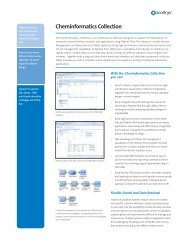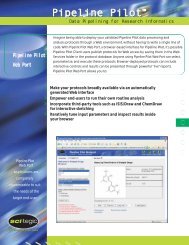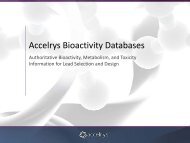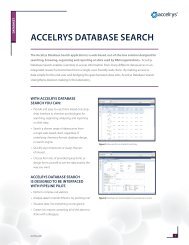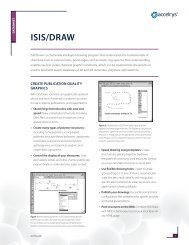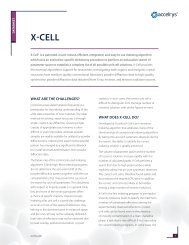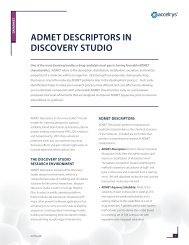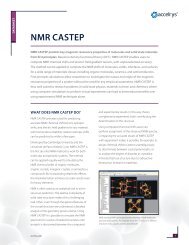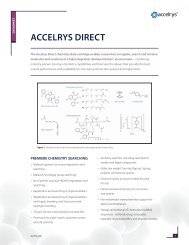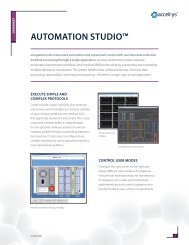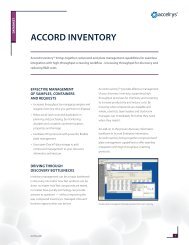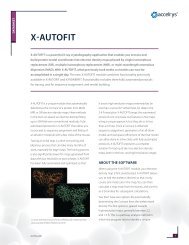Read the Reflex Plus Datasheet - Accelrys
Read the Reflex Plus Datasheet - Accelrys
Read the Reflex Plus Datasheet - Accelrys
You also want an ePaper? Increase the reach of your titles
YUMPU automatically turns print PDFs into web optimized ePapers that Google loves.
DATASHEET<br />
reflex PluS<br />
<strong>Reflex</strong> <strong>Plus</strong> is an advanced version of <strong>Reflex</strong>, adding <strong>the</strong> extensively validated Powder Solve1,2 technology to <strong>the</strong> standard <strong>Reflex</strong> functionality. <strong>Reflex</strong> <strong>Plus</strong> offers a complete package for<br />
determining crystal structures from medium-to-high quality powder diffraction data.<br />
The ideal method for solving crystal structures<br />
is single-crystal X-ray diffraction. Growing single<br />
crystals of appropriate size, however, is often<br />
difficult or even impossible, whereas powder<br />
samples are readily available for analysis by powder<br />
diffractometry.<br />
Despite <strong>the</strong> problems associated with peak<br />
overlap, a high-quality powder diffraction pattern<br />
generally contains enough information for<br />
unambiguously determining <strong>the</strong> corresponding<br />
crystal structure. A number of techniques are<br />
available to index <strong>the</strong> pattern, which allows<br />
cell parameters to derive from <strong>the</strong> positions<br />
of diffraction peaks. Knowledge of systematic<br />
absences can help determine <strong>the</strong> most likely<br />
space groups. Taking into account <strong>the</strong> molecular<br />
connectivity and <strong>the</strong> wellknown geometry<br />
of certain molecular fragments, <strong>the</strong> atomic<br />
arrangement in <strong>the</strong> unit cell can be described by<br />
a small number of parameters. It is possible to<br />
determine <strong>the</strong>se structural parameters from <strong>the</strong><br />
intensity distribution of <strong>the</strong> powder diffraction<br />
pattern, although solving crystal structures<br />
from powder diffraction data remains a difficult<br />
computational problem for more complex crystals.<br />
The Powder Solve APProAch<br />
<strong>Reflex</strong> <strong>Plus</strong> helps you to solve various problems:<br />
• The <strong>Reflex</strong> Powder Indexing tools allow you<br />
to determine <strong>the</strong> cell parameters and crystal<br />
accelrys.com<br />
Figure 1: This structure of <strong>the</strong> drug cimetidine was determined from<br />
its experimental powder diffraction pattern (pictured inside) using <strong>the</strong><br />
Powder Solve technology.<br />
system by indexing <strong>the</strong> experimental powder<br />
diffraction pattern<br />
• The modified Pawley procedure available in <strong>the</strong><br />
<strong>Reflex</strong> Powder Refinement module refines <strong>the</strong><br />
cell parameters, peak shape, and background<br />
parameters, and is a helpful tool for confirming<br />
<strong>the</strong> indexing result and narrowing down <strong>the</strong> list<br />
of possible space groups<br />
• The Powder Solve algorithm performs a search<br />
of possible arrangements and conformations of<br />
<strong>the</strong> molecular fragments in <strong>the</strong> unit cell. It finds<br />
a structure for which <strong>the</strong> simulated powder<br />
pattern matches <strong>the</strong> experimental one as closely<br />
as possible and is also chemically viable<br />
• A final refinement of <strong>the</strong> proposed solution<br />
is performed with <strong>the</strong> rigid-body Rietveld<br />
refinement functionality available in <strong>Reflex</strong>.<br />
1
Powder IndexIng<br />
Indexing <strong>the</strong> experimental powder pattern is often <strong>the</strong> most<br />
challenging step in determining crystal structures from powder<br />
diffraction data. Four methods are provided for indexing powder<br />
patterns: TREOR903 , DICVOL914 , ITO155 , and X-Cell6 . It is important<br />
to use a high-quality powder pattern. Such a powder pattern<br />
typically contains narrow peaks that show little overlap with<br />
o<strong>the</strong>r peaks, making it easy to identify each peak’s 2θ position.<br />
Once <strong>the</strong> cell parameters and lattice class have been determined,<br />
systematic absences can be used to limit <strong>the</strong> number of possible<br />
space groups.<br />
While synchrotron sources usually provide powder patterns<br />
that are more easily indexed, high-quality laboratory powder<br />
diffraction data can also be used with success. The higher <strong>the</strong><br />
quality of your powder pattern, <strong>the</strong> more detailed information it<br />
contains, and subsequently <strong>the</strong> greater your chance of success.<br />
PAwley refInemenT<br />
Once indexing is complete, a list of possible space groups must<br />
be established based on chirality, density, and consideration of<br />
systematic absences. The Pawley refinement functionality helps<br />
confirm <strong>the</strong> indexing result and explore <strong>the</strong> effect of systematic<br />
absences, aiding in <strong>the</strong> determination of <strong>the</strong> possible space<br />
groups. In Pawley refinement, various parameters are adjusted<br />
to minimize <strong>the</strong> weighted R-factor, Rwp, that describes <strong>the</strong><br />
agreement between <strong>the</strong> experimental powder diffraction pattern<br />
and a simulated one.<br />
Peak intensities are treated as independent parameters. In<br />
addition, a wide range of variables can be refined, such as <strong>the</strong><br />
unit cell, <strong>the</strong> background, a choice of peak profile and asymmetry<br />
functions, crystallite size, lattice strain, and <strong>the</strong> zero point shift<br />
of <strong>the</strong> diffraction pattern. By repeating <strong>the</strong> Pawley refinement<br />
in different space groups, <strong>the</strong> effect of systematic absences on<br />
<strong>the</strong> simulated powder diffraction pattern is readily visualized.<br />
The refinement is based on a modified Pawley1,6 procedure that<br />
consists of two steps. In step one, <strong>the</strong> integrated intensities and<br />
background coefficients are optimized while <strong>the</strong> peak shape,<br />
cell parameters, and zero-point shift are fixed. In step two, <strong>the</strong><br />
accelrys.com<br />
DATASHEET: MATEriAlS STuDio<br />
opposite takes place, with all parameters being optimized except<br />
for <strong>the</strong> intensities and background coefficients. This two-step<br />
process is continued until convergence is achieved.<br />
Powder Solve<br />
The next step for structure determination involves Powder<br />
Solve; an indirect method that employs a Monte Carlo simulated<br />
annealing or parallel tempering algorithms. Before starting<br />
Powder Solve, <strong>the</strong> user must define each torsional degree of<br />
freedom to be explored during <strong>the</strong> simulation. One degree of<br />
freedom in <strong>the</strong> system, i.e., translational, rotational, or torsional, is<br />
modified by a random amount during each simulated annealing<br />
step, after which a powder pattern is calculated. This simulated<br />
pattern is <strong>the</strong>n compared to <strong>the</strong> experimental powder pattern<br />
using Rwp as a measure of similarity.<br />
Optionally, Powder Solve allows to apply a close contact penalty<br />
function during structure determination. This option is particularly<br />
useful when working with low-quality powder data, as it will<br />
ensure that Powder Solve finds chemically feasible solutions,<br />
without bad contacts between structural fragments. When a<br />
promising structure is found Powder Solve performs a rigid-body<br />
Rietveld refinement with respect to <strong>the</strong> parameter space to locate<br />
<strong>the</strong> local minimum. The iterative process of modifying one degree<br />
of freedom and comparing powder patterns continues in order to<br />
minimize Rwp. Structures with low Rwp values are automatically<br />
saved to trajectory files. Multiple cycles to determine <strong>the</strong> structure<br />
are performed in order to confirm <strong>the</strong> final solution. A wide<br />
range of compounds have been successfully examined using this<br />
methodology, including solvates, salts, and flexible molecules.<br />
rIeTveld refInemenT<br />
The final step for structure determination is Rietveld refinement8,9 where users can refine candidate crystal structures obtained from<br />
Powder Solve against experimental powder diffraction data by<br />
minimizing <strong>the</strong> weighted R-factor, Rwp. Flexibility is provided<br />
through <strong>the</strong> wide range of refinement parameters available -<br />
unit cell, atomic, peak profile and asymmetry, crystallite size and<br />
strain broadening, preferred orientation, background, zero-point<br />
shift, intensities. Rietveld refinement with energies incorporates<br />
an accurate description of potential energy in conjunction<br />
2
with Rwp during a Rietveld refinement process optimizing a<br />
combined figure of merit so that not only <strong>the</strong> simulated pattern<br />
of <strong>the</strong> resulting structure matches <strong>the</strong> experimental diffraction<br />
data, but also <strong>the</strong> potential energy of <strong>the</strong> structure is close to a<br />
global minimum. Pareto optimization10 can be used to calculate<br />
a set of possible optimal refinement solutions automatically as a<br />
sequence of Rietveld refinement with energies calculations with<br />
changing energy weights. Pareto optimization for a structure<br />
solution represents a trade-off to provide best possible Rwp(min)<br />
and energy(min) compromises.<br />
The mATerIAlS STudIo AdvAnTAge<br />
<strong>Reflex</strong> <strong>Plus</strong> is a operated within <strong>the</strong> Materials Studio®<br />
environment, allowing for a high degree of interactivity with<br />
o<strong>the</strong>r Materials Studio products and Windows® applications. The<br />
molecules or molecular fragments used in <strong>the</strong> structure search<br />
can be easily constructed using Materials Studio sketching and<br />
molecular mechanics tools, or by being imported from o<strong>the</strong>r<br />
sources.<br />
Results obtained by indexing, Pawley refinement, structure<br />
solution, and Rietveld refinement are readily passed on between<br />
<strong>the</strong> different modules involved in <strong>the</strong> structure determination<br />
procedure. A powerful rigid body Rietveld refinement program<br />
is available to carry out <strong>the</strong> final structure refinement. Crystal<br />
structures are readily visualized using Materials Visualizer.<br />
Figure 2: Comparison of <strong>the</strong> experimental powder diffraction pattern of cimetidine with <strong>the</strong><br />
pattern simulated for <strong>the</strong> crystal structure as determined by <strong>Reflex</strong> <strong>Plus</strong>.<br />
accelrys.com<br />
DATASHEET: MATEriAlS STuDio<br />
Finally, results can easily be shared with colleagues and copied<br />
and pasted to standard word processors, spreadsheets, and<br />
presentation packages.<br />
feATureS<br />
general<br />
• <strong>Reflex</strong> <strong>Plus</strong> is a complete package for structure determination<br />
from powder diffraction data, covering indexing, Pawley<br />
refinement, structure solution, and Rietveld refinement<br />
• <strong>Read</strong>s in a variety of diffractometer file formats including Bruker,<br />
Stoe, Scintag, Jade, Philips, JCAMP, Galactic SPC, GSAS raw, ILL,<br />
PAnalytical XRDML<br />
• Allows for different X-ray sources with multiple wavelengths<br />
and user-defined polarization<br />
• Suitable for X-ray, neutron, and electron diffraction.<br />
• Can handle any possible space group, both standard and nonstandard<br />
settings, accounting for systematic absences<br />
• Benefits from straightforward interaction with o<strong>the</strong>r Materials<br />
Studio products as well as o<strong>the</strong>r PC applications<br />
• Pawley refinement and Rietveld refinement jobs can<br />
be submitted to remote server machines in addition to<br />
synchronous execution on local client<br />
• Powerful but easy to use; intuitive definition of degrees of<br />
freedom<br />
Powder Solve<br />
• Final parameters from Pawley refinement are automatically<br />
transferred to Powder Solve<br />
• Choice of two global search algorithms,MC simulated annealing<br />
and MC parallel tempering<br />
• Close contact penalty function ensures chemically viable<br />
solutions<br />
• Automated tool to estimate <strong>the</strong> appropriate number of steps<br />
for each structure solution problem<br />
• Determination of preferred orientation correction during<br />
structure solution search<br />
3
• Automatic setting of all simulation parameters.<br />
• Multiple structure solution cycles can be performed to<br />
confirm results<br />
• As structures produce lower Rwp values, <strong>the</strong>y are saved to a<br />
trajectory file<br />
• Automatic rigid body Rietveld refinement of promising<br />
structures during structure solution search<br />
• Extensive analysis tools to examine results from single or<br />
multiple structure solution cycles<br />
• Proposed solution can be fur<strong>the</strong>r refined with <strong>the</strong> rigid body<br />
Rietveld Refinement tool<br />
referenceS:<br />
accelrys.com © 2011 <strong>Accelrys</strong> Software Inc. All brands or product names may be trademarks of <strong>the</strong>ir respective holders.<br />
DATASHEET: MATERIALS STUDIo<br />
• Works with good quality lab data as well as synchroton data<br />
• Based on full profile comparison - moderate peak overlap not<br />
a problem<br />
• Well validated for complex compounds, including solvates,<br />
salts, and flexible molecules<br />
• Works for organics and inorganics<br />
• Client-server architecture allows calculations to run on powerful<br />
servers, while analysis is performed<br />
To learn more about Materials Studio, go to<br />
accelrys.com/materials-studio<br />
1. G.E. Engel, S.Wilke,O. König, K.D.M.Harris and F.J.J. Leusen, J. Appl. Cryst., 1999, 32, 1169-1179.<br />
2. G. A. Stephenson, J. Pharm. Sci., 2000, 89, 958.<br />
3. P.E.Werner, L. Eriksson and M.Westdahl, J. Appl.Cryst., 1968, 1, 108-113.<br />
4. A. Boultif and D. Louer, J. Appl. Cryst., 1991, 24, 987.<br />
5. J.W.Visser, J. Appl. Cryst., 1969, 2, 89.<br />
6. M.A.Neuman, J. Appl. Cryst., 2003, 36, 356-365.<br />
7. G.S. Pawley., J. Appl. Cryst., 1981, 14, 357.<br />
8. H. M. Rietveld, J. Appl. Cryst., 2, 65-71 (1969).<br />
9. R. A.Young, “The Rietveld Method”, Oxford University Press (1993).<br />
10. D.A.Van Veldhuinzen, G.B. Lamont, Evolutionary Computation, 8, 125 (2000).<br />
DS-8047-0811<br />
4



